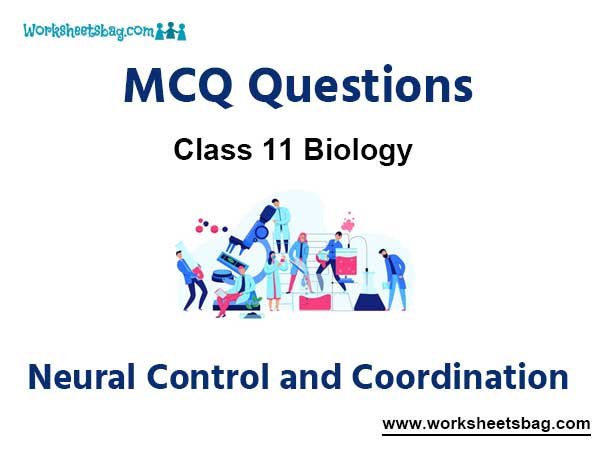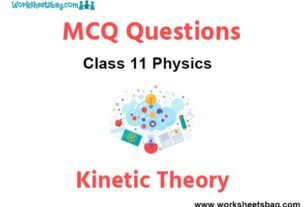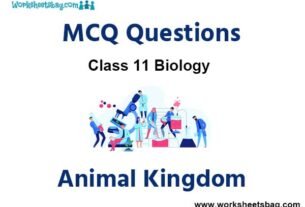Please refer to Neural Control and Coordination MCQ Questions Class 11 Biology below. These MCQ questions for Class 11 Biology with answers have been designed as per the latest NCERT, CBSE books, and syllabus issued for the current academic year. These objective questions for Neural Control and Coordination will help you to prepare for the exams and get more marks.
Neural Control and Coordination MCQ Questions Class 11 Biology
Please see solved MCQ Questions for Neural Control and Coordination in Class 11 Biology. All questions and answers have been prepared by expert faculty of standard 11 based on the latest examination guidelines.
MCQ Questions Class 11 Biology Neural Control and Coordination
Question- The controlling centre of autonomic nervous system is
(a) hypothalamus
(b) spinal cord
(c) cerebellum
(d) pons
Answer
A
Question- A bipolar neuron has
(a) 2 dendrites and 1 axon
(b) 2 axons and 1 dendrite
(c) 1 dendrite and 1 axon
(d) 2 axons and 2 dendrites
Answer
C
Question- Pons connects
(a) brain with spinal cord
(b) cerebrum with cerebellum
(c) two-lobes of cerebellum
(d) two cerebral hemispheres
Answer
C
Question-During conduction of nerve impulse
(a) Na+ moves into axoplasm
(b) Na+ moves out of axoplasm
(c) K+ moves into axoplasm
(d) Ca++ moves into axoplasm
Answer
A
Question- Purkinje cells are found in
(a) cerebellar cortex
(b) mammalian heart
(c) voluntary cells
(d) semicircular canal
Answer
C
Question- Which of the following ions are required for nerve conduction ?
(a) Ca++, Na+ and K+
(b) Ca++ and Mg++
(c) Mg++ and K+
(d) Na+ and K+
Answer
A
Question- During rest, sodium pump of a nerve results in
(a) more Na+ pumped out than K+ ions taken in.
(b) Na+ pumped in without exchange with any other ion.
(c) exchanging equal amounts of Na+ and K+.
(d) more Na+ being pumped in than K+ ions pumped out.
Answer
A
Question- Twilight vision is also called
(a) scotopic vision and is the function of rods.
(b) scotopic vision and is the function of cones.
(c) photopic vision and is the function of rods.
(d) photopic vision and is the function of cones.
Answer
A
Question- A typical value of resting membrane potential is
(a) – 40m V
(b) – 60m V
(c) – 70m V
(d) – 80m V
Answer
C
Question- Which of the following is devoid of blood supply?
(a) Retina
(b) Choroid
(c) Cornea
(d) Scleroid
Answer
C
Question- The cerebral cortex is
(a) the outer layer of cerebrum, called white matter.
(b) inner layer of cerebrum, called white matter.
(c) the outer layer of cerebrum, called grey matter.
(d) inner layer of cerebrum, called grey matter.
Answer
C
Question- The secretion of gastric juice is controlled by
(a) cerebellum
(b) ANS
(c) cerebrum
(d) medulla
Answer
D
Question- Sodium – Postassium pump across membrane, actively transports
(a) 2 Na ions outwards and 3 K ions into the cell.
(b) 3 Na ions outwards and 2 K ions into the cell.
(c) 2 K ions outwards and 3 Na ions into the cell.
(d) 3 K ions outwards and 2 Na ions into the cell.
Answer
B
Question- Centre for sense of smell is
(a) cerebellum
(b) olfactory lobes
(c) pons
(d) midbrain
Answer
B
Question- Which is not a reflex action?
(a) Swallowing of food
(b) Shivering in cold
(c) Salivation at choicest food
(d) Closure of eyelid by flashing light
Answer
B
Question- Clusters of neuron cell bodies embedded in the white matter of the brain are referred to as
(a) nuclei
(b) gyri
(c) sulci
(d) ganglia
Answer
A
Question- The nerves carrying impulses to CNS are known as
(a) motor
(b) efferent
(c) afferent
(d) mixed
Answer
C
Question- In static condition, the body balance is sensed by
(a) crista
(b) macula
(c) both (a) and (b)
(d) cochlear canal
Answer
B
Question- Part of brain responsible for hearing is
(a) cerebellum
(b) cerebrum
(c) medulla
(d) hypothalamus
Answer
B
Question- The transmission of impulse through neurons is a
(a) physical phenomenon
(b) chemical phenomenon
(c) electro-chemical phenomenon
(d) gravitational phenomenon
Answer
C
Question- Action potential of nerve cell is
(a) – 60 mV
(b) –80 mV
(c) +20 mV
(d) +30 mV
Answer
D
Question- During recovery, a nerve fibre becomes
(a) positively charged outside and negatively charged inside.
(b) positively charged on both-outside and inside.
(c) negatively charged outside and positively charged inside.
(d) negatively charged on both-outside and inside.
Answer
A
Question- Which of the following cell in the central nervous system functionally equivalent to a Schwann cell?
(a) astrocyte
(b) neuron
(c) oligodendrocyte
(d) microglial cell
Answer
C
Question- The resting potential occurs because
(a) of reduced energy production by mitochondria.
(b) the action potential depletes transmitter substance.
(c) of the different concentrations of ions across the cell.
(d) the action potential causes axoplasmic transport back towards the cell body.
Answer
C
Question- Anvil-shaped bone is
(a) malleus
(b) incus
(c) stapes
(d) columella auris
Answer
B
Question- Which of the following group of functions was regulated by part of hindbrain?
(a) Sexual behaviour, body temperature, drinking.
(b) Gastric secretion, cardiovascular reflexes, respiration.
(c) Memory and communication, cardiovascular reflexes, respiration.
(d) Gastric secretion, body temperature, Memory and communication.
Answer
B
Question- In the axons, the nerve impulse travels.
(a) towards the cell body.
(b) away from the cell body.
(c) away from synapse.
(d) in both direction.
Answer
B
Question- The thinned-out portion of retina where only cones are densely packed is called
(a) blind spot
(b) corpus luteum
(c) macula lutea
(d) fovea
Answer
D
Question- Bony labyrinth of ear contains a fluid known as
(a) endolymph
(b) perilymph
(c) aqueous humour
(d) synovial fluid
Answer
B
Question-The region of vertebrate’s eye where the optic nerve passes out of the retina is called
(a) yellow spot
(b) optic chiasma
(c) fovea
(d) blind spot
Answer
D
Question- In which part of the mammalian ear, the nerve impulse for hearing starts?
(a) Eardrum
(b) Ear ossicles
(c) Cochlea
(d) Auditory nerve
Answer
C
Question- For seeing the nearby objects, the lens becomes more convex by
(a) relaxation of iris muscles.
(b) contraction of iris muscles.
(c) contraction of ciliary muscles.
(d) relaxation of ciliary muscles.
Answer
C
Question- Space between cornea and lens is called
(a) aqueous chamber
(b) vitreous chamber
(c) canal of schlemm
(d) fovea centralis
Answer
A
Question- In human eye, the blind spot contains
(a) rods
(b) cones
(c) both rods and cones
(d) neither rods nor cones
Answer
D
Question- Pons varolii in human brain lies
(a) anterior to optic chiasma
(b) posterior to medulla oblongata
(c) ventral to cerebellum
(d) dorsal to diencephalon
Answer
C
Question- Eye ball is moved in the orbit by
(a) four rectus and two oblique muscles
(b) ciliary muscles
(c) suspensory ligaments
(d) two rectus and four oblique muscles
Answer
A
Question- Which part of the human eye adjust the focal length of lens ?
(a) Aqueous humour
(b) Ciliary body
(c) Conjunctiva
(d) Cornea
Answer
B
Question- Part of mammalian brain controlling muscular coordination is
(a) cerebrum
(b) corpus callosum
(c) medulla oblongata
(d) cerebellum
Answer
D
Question- Colour perception in man is due to the presence of
(a) rhodopsin pigment in rod cells.
(b) iodopsin pigment in cone cells.
(c) iodopsin pigment in rod cells.
(d) rhodopsin pigment in cone cells.
Answer
B
Question- The cochlea of ear contains
(a) perilymph
(b) aqueous humour
(c) perilymph and endolymph
(d) only endolymph
Answer
C
Question- At the base of cochlea, the canal that ends at the oval window is
(a) scala tympani
(b) scala media
(c) scala vestibuli
(d) auditory
Answer
C
Question- Which of the following is a thin middle layer of cranial meninges?
(a) Duramater
(b) Arachnoid
(c) Piamater
(d) Optic nerve
Answer
B
Question- Macula of labyrinth is bathed in
(a) aqueous humour
(b) vitreous humour
(c) perilymph
(d) endolymph
Answer
D
Question- The amount of light that falls on retina is regulated by
(a) lens
(b) cornea
(c) iris
(d) ciliary muscles
Answer
C
Question- The sense of equilibrium is determined by
(a) basilar membrane of cochlea.
(b) tectorial membrane of cochlea.
(c) sensory crista of ampulla.
(d) sensory cells of organ of corti.
Answer
C
Question- Receptor cells for balance in human ear are located in
(a) utricle, saccule and semicircular canal
(b) malleus, incus and stapes
(c) organ of corti
(d) Eustachian tube
Answer
A
Question- Corpus callosum connects
(a) two cerebral hemispheres
(b) two ventricles of brain
(c) two cerebellar hemispheres
(d) two optic thalamus
Answer
A
Question- The stereocilia of hair cells of organ of Corti are covered with a thick elastic membrane called
(a) Reissner’s membrane
(b) basilar membrane
(c) tympanic membrane
(d) tectorial membrane
Answer
D
Question- The blind spot is the region where
(a) image is formed.
(b) cones are numerous.
(c) the optic nerve leaves out.
(d) image is formed during the dark.
Answer
C
Question-In mammalian cochlea, the thin-walled sloping roof of the scala media is referred to as
(a) organ of Corti
(b) scala tympani
(c) basilar membrane
(d) reissner’s membrance
Answer
D
Question- In mammals, the organs of Corti is found in
(a) scala vestibule
(b) scala tympani
(c) scala media
(d) middle ear
Answer
C


